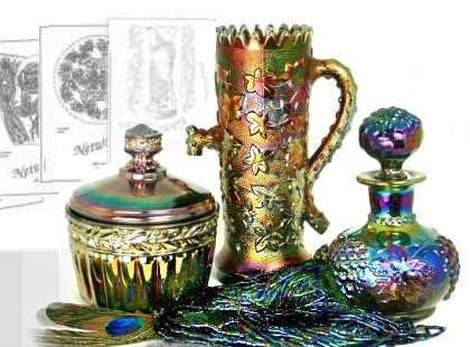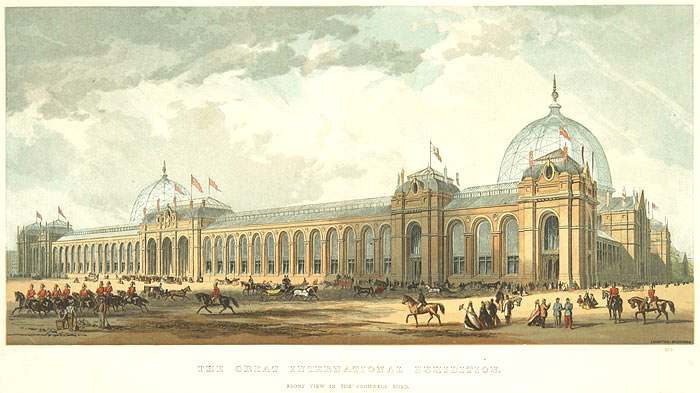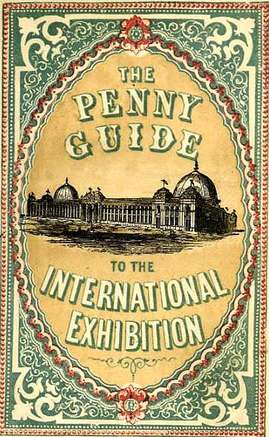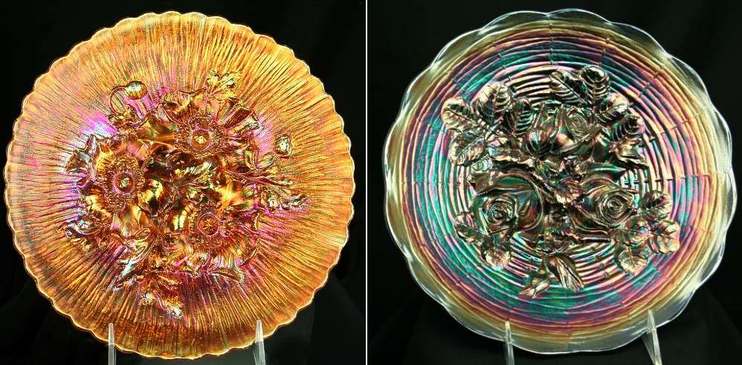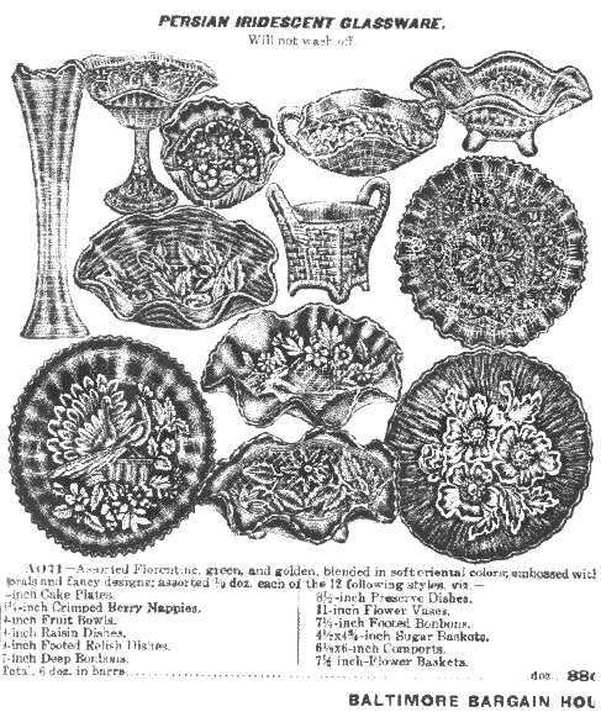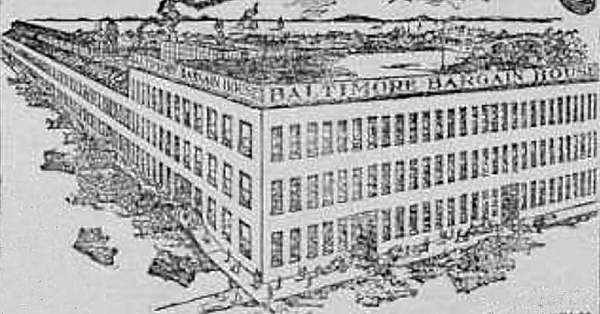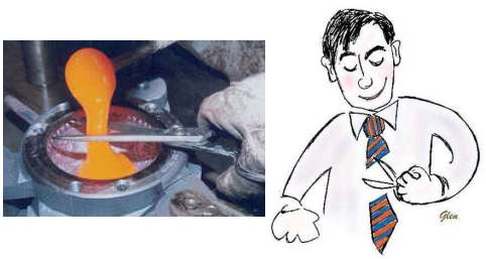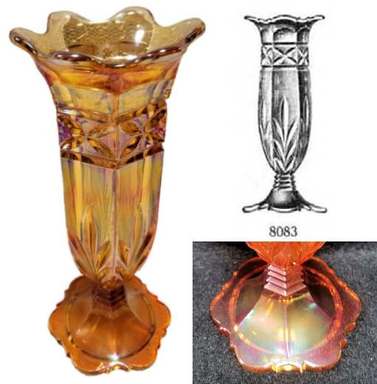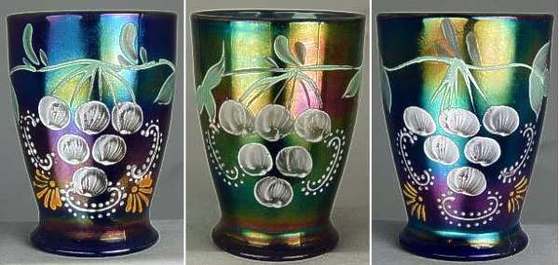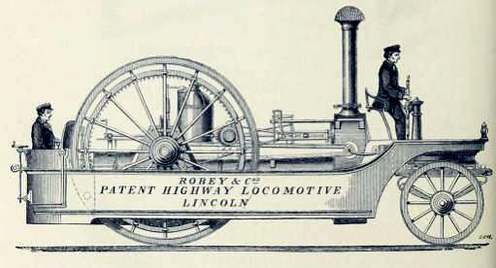NetworK ezine Issue 29. October 2017
Totally Devoted to Carnival Glass
|
DISCOVERY ISSUE #2: The Second of two Discovery Specials
Welcome to your October NetworK, our 36th issue of NetworK and NetworK Specials since the launch of our ezine in 2015. It’s a very special month for us as it marks the first birthday of our Carnival NetworK Facebook Group, and our membership has grown to an astonishing 6000 in the first year. Discovery is a constant theme in the Group … discovering new finds, identifying mystery pieces, exploring and appreciating the beauty of Carnival and sharing research and knowledge with collectors all over the world. Our tale of Discovery in this issue is a major one, as without this discovery there would be no Carnival Glass at all. The discovery goes back to the true origins of Carnival Glass, to the very genesis of iridescence on glass. It is fundamental to all Carnival Glass, as without it, pieces such as the ones shown on the right may never have been made. The pieces shown here are, left to right: Laurel Band bonbonniere, blue (Riihimaki), Town Pump, purple (Northwood), Vintage perfume, purple (Dugan), and in front a peacock feather and a Carnival bead necklace. |
It’s a tale that will resonate with many: it involves Fake News and probably industrial espionage, and it all began at the 1862 World's Fair in London.
|
Imagine life without the internet, without Facebook and other social media. Think what it would be like if there were no TV, no radio, no cars, no airplanes. What did people do for entertainment? How did they find out what was going on in the rest of the world? That’s where the World's Fairs came in. They were incredibly popular and successful, drawing in many millions of visitors and exhibitors from all over the world. On May 1st, 1862, at 10 am precisely, the London World's Fair opened to the public. Season ticket holders and day visitors flooded into the majestic halls and pavilions. Shown below is the cover of the Penny Guide to the Fair, which provided the visitors with a floor plan and guide to the many countries exhibiting. The visitors were met by incredible sights – engines, tools and machines of every kind, statues, portraits, confectionary and towering cakes, plants, furniture, fabrics and many thousands of items besides. |
Above: The World's Fair - International Exhibition – London 1862.
Public Domain. |
|
Nestled amongst the candelabras and decorative glass, was the fore-runner of Carnival Glass. Shown below is an iconic piece of history. This is the entry in the main catalogue of exhibitors at the London World Fair in 1862, for Joseph Zahn’s company at Zlatno (Steinschonau). It is a very understated entry ... but it records a monumental piece of glass history. For the very first time ever iridescent glass was shown to the world. How did it all happen?
In reality, the story began some five or six years earlier when Leo Pantocsek, a scientist working at J. G. Zahn’s glassworks in Zlatno, invented a method of iridising glass. It was a ground breaking and astonishing discovery, and Zahn decided to show off this splendid glass at the 1862 London Fair. Zahn's exhibit - being shown to the world for the first time ever - included intentionally-made iridescent glass ... glass created by Leo Valentin Pantocsek and made at Zahn's glassworks. But instead of setting the glass world alight, it “dropped off the radar” … that is, until just a few years later (and very probably thanks to a classic case of industrial espionage) when a bigger, well-known glass firm got in on the act. Picture it. Vienna, 1873 and a new World's Fair that attracted over 7 million visitors. Zahn put on a display of his own again, but he was a relatively small player in the glassmaking world (as his understated trade |
In Vienna, all eyes were on the magnificent, show-stopping display of the new iridescent glass presented by the famous, and local Viennese firm, J & L Lobmeyr. Lobmeyr's glass took the world by storm and soon glassmakers everywhere were producing their own versions of iridescent glass. The Lobmeyr brothers were businessmen - they saw and developed its phenomenal potential. But in a classic case of Fake News, opinion emerged that claimed the Lobmeyrs were the first to “invent” and produce iridescence on glass. Indeed, the story of fireworks in the Lobmeyr furnace (resulting in iridescent glass) still persists and yes, it caught us out for a while!
Read the full, amazing story from its beginnings to the advent of Carnival Glass: Pantocsek – The Father of Iridescence on Glass.
Read the full, amazing story from its beginnings to the advent of Carnival Glass: Pantocsek – The Father of Iridescence on Glass.
Discovery and Proof - Rose Show and Poppy Show
Collectors today don't usually give it a second thought - Rose Show and Poppy Show were made by Northwood. True - but in the early years of Carnival collecting, and indeed into the 1980s and 90s, the maker of these pieces was not fully confirmed. The colours they were found in led to the belief that Northwood was the maker, but firm evidence proved impossible to find.
Collectors today don't usually give it a second thought - Rose Show and Poppy Show were made by Northwood. True - but in the early years of Carnival collecting, and indeed into the 1980s and 90s, the maker of these pieces was not fully confirmed. The colours they were found in led to the belief that Northwood was the maker, but firm evidence proved impossible to find.
Until ... we were sent this 1913 ad!
Our friend, Karen McIntyre, had obtained a 1913 Baltimore Bargain House catalogue, and she showed us the delightful ad (above) in it for “Persian Iridescent Glassware”. We almost fell over in surprise when we realised the significance of the pieces it showed.
|
Here, for the very first time, was an ad showing a magnificent range of known Northwood (marked) items alongside Rose Show and Poppy Show. The patterns shown in the ad are all Northwood. From the top and left to right: Four Pillars vase; Hearts and Flowers compote; Poppy pickle dish; Grape and Cable handled bonbon; Fine Cut and Roses footed candy dish; Rose Show bowl; Bushel Basket; pie crust edge Hearts and Flowers bowl; ruffled Peacocks bowl; Peacocks plate; Lattice and Poinsettia bowl; Poppy Show plate. Karen’s "find" was the missing link we had all wanted for so long. We have shown this amazing discovery before*, but as we have so many new readers, we felt it was right to feature it again. And we always think it’s right that you can’t have too much of a good thing! * we first showed this ad to the Carnival Glass world in the millennium year 2000 in our original (printed) NetworK Journal #25. |
Above: Baltimore Bargain House - just one of their warehouses.
It was a big operation! |
A Tribute to Howard Seufer
|
We were so saddened to hear the news that Howard Seufer passed away on Sunday September 10th, 2017. Howard was an industrial engineer for Fenton Art Glass Company and had done so much for glass collectors in general, and Carnival Glass collectors in particular, over many decades. He led many of us on a constant voyage of Discovery – teaching us all how the glass was made, as well as helping us to discover more about its beauty. Howard made learning such fun - his presentations and talks to Carnival Glass collectors are legendary. Nobody who watched him take a pair of shears to his own necktie, and … snip … can ever forget how a “Shear Mark” is formed on Carnival Glass. Below, right is Howard's unforgettable demonstration of a shear mark in pressed glass. A shear mark (often incorrectly called a “straw” mark) is a short, straight mark, about an inch long, on the surface of the glass. It was caused by the glassmaker cutting off the molten glass with cold shears as it dropped into the mould (above, left) . Howard’s delightful demonstration of the process ensured that once seen, it would never be forgotten. |
|
Rest in peace, Howard. Your legacy lives on forever. We have many features and articles on our website that Howard contributed to – here are just a few of our favourites: What is a Straw Mark /Shear Mark? Click HERE Features and defects of Handmade Pressed Glass Click HERE The Art and Craft of Mouldmaking Click HERE Butterfly and Tulip – the re-birth Click HERE Is it Safe to Use Carnival (with food) Click HERE |
|
Western Centaury Vase Discovery A wonderful discovery has been reported to us by Dave and JoAnne Cotton. This magnificent vase, with its scintillating iridescence, stands 8.5 inches high on a pedestal base. The curving detail on the foot itself is fascinating and indicates a high-quality manufacturer. Dave and JoAnne identified the maker from our (printed) NetworK Journal Special #1 on Czechoslovakian Carnival, that we issued back in 2002. It was Josef Inwald, and the vase had the number 8083. JoAnne set out to identify the flower depicted on the vase, and she and Dave named it accordingly “Western Centaury” (from the species Centaurium erythraea, a form of gentian) – a beautiful and unusual pattern name for this splendid vase. Right: Western Centaury vase and detail of the foot (pictures courtesy of Dave and JoAnne Cotton, and the Inwald catalogue image of their pattern #8083. |
My Little Secret #3: Northwood’s Ground Cherries
Northwood’s Ground Cherries tumbler is known mainly in blue, with an intriguing enamelled design - white “ground cherries” hanging from a lateral stem, bordered by three curving motifs and two bright orange partial flower heads. The matching pitcher features full flower heads, in orange and white.
So, what’s the little secret? Look at the middle tumbler in the picture. It doesn't have the orange flower heads or the lower curving motif (or as we call it in the database of our collection - "absentee twiddly bits"!)
Northwood’s Ground Cherries tumbler is known mainly in blue, with an intriguing enamelled design - white “ground cherries” hanging from a lateral stem, bordered by three curving motifs and two bright orange partial flower heads. The matching pitcher features full flower heads, in orange and white.
So, what’s the little secret? Look at the middle tumbler in the picture. It doesn't have the orange flower heads or the lower curving motif (or as we call it in the database of our collection - "absentee twiddly bits"!)
|
What was going on? Northwood and Fenton had large decorating departments within their factories – the foreman of Northwood’s Decorating Shop was Carl Northwood. The paintwork was hand done, and the artist would have had a template model design to work from and copy. She (most likely the painters were women) would have worked quickly, reproducing the same pattern on piece after piece, in a “broad brush” style. So, what do you think happened on the Ground Cherries tumbler with the missing flowers and curves? What was the secret? Did the decorator run out of paint? Did she feel unwell and have to stop work? Was she aiming to express herself and do something different? Or perhaps she was trying to work faster and simply forgot. What do you think that little secret was? |
Footnote: what exactly is a ground cherry? It’s what some of us know as physalis or Cape gooseberry. The fruits are actually orange, and the flowers (as it is from the nightshade family) are tiny and white to pale yellow in colour.
And what were those tumblers shown in this month's header?
They are all European tumblers. From left to right: Banded Western Thistle (Riihimaki) in marigold and blue, Western Thistle (Riihimaki) in three different shapes (blue cupped in barrel shape, marigold flared, blue straight up), Fir Cones (Riihimaki) blue, Nola (Inwald) marigold in two sizes, Laurel Band (Riihimaki) blue, Starburst and Crown (Riihimaki) in two different shapes (marigold cupped in barrel shape and marigold straight up), Starburst (Riihimaki) in green, Britt (Karhula) in blue and marigold.
Join us on Facebook
We invite you and your friends to join us all on NetworK's fast growing and very active Facebook Group (link is below), and if you have missed any of the previous issues of NetworK and NetworK Specials, they are all here: Back Issues.
We invite you and your friends to join us all on NetworK's fast growing and very active Facebook Group (link is below), and if you have missed any of the previous issues of NetworK and NetworK Specials, they are all here: Back Issues.

